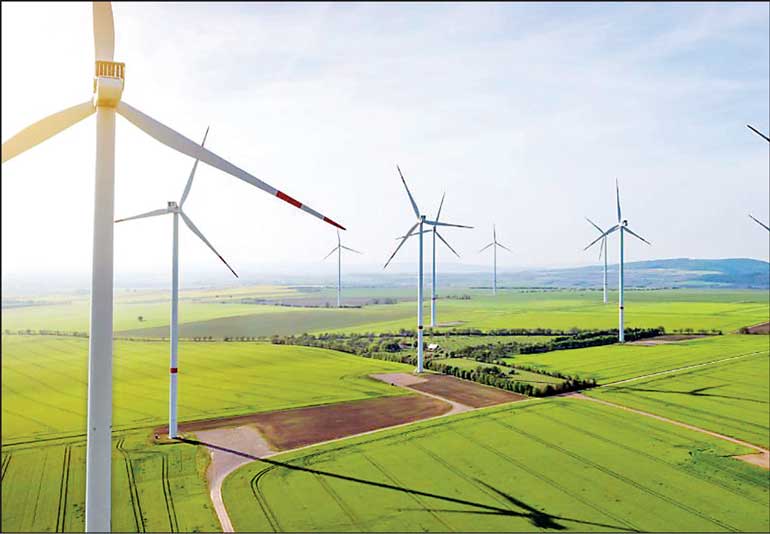Monday Apr 21, 2025
Monday Apr 21, 2025
Thursday, 6 June 2024 00:00 - - {{hitsCtrl.values.hits}}

By a Special Correspondent
Sri Lanka has set an ambitious goal of achieving 70% renewable energy generation by 2030 and becoming carbon neutral by 2050. To put this in perspective, for FY24, fossil fuel-based power plants met 54% of total power generated in the country, and under 8% came from solar or wind, with hydro contributing 31%. In terms of installed capacity, as on 31 March 2024, of SL’s generation capacity of 5,012 MW, ex of hydro, REs contributed barely 1093 MW, which is about a fifth of the total installed capacity. With limited scope of adding large-scale hydro projects in the future, it is the wind and solar projects which will have to do the heavy lifting for SL to meet its RE generation goals.
Over the next 25 years, the country’s power demand is projected to grow at an annualised rate of ~5% and SL will need to add ~7,000 MW of fresh RE, mainly consisting of ~4,700 MW of solar and ~1,800 MW of wind power. According to a joint study conducted by the United Nations Development Programme and the Asian Development Bank, Sri Lanka houses a potential of 16 GW solar power. World Bank estimates Sri Lanka’s offshore wind potential is 92 GW.
Much of the additional capacity will need to come from private sector as CEB won’t be able to fill the gap entirely on its own. Its own RE capacity has been rather stagnant at 100MW for years. Private sector power producers, also referred to as Independent Power Producers (IPP), have 163 MW of wind and 137 MW of solar currently.
What Sri Lanka needs is projects that will actually generate and supply affordable power and not projects which will remain in papers, as has been seen in the past.
India’s Adani group has proposed to set up SL largest RE project by investing $ 740 million to generate 484 MW of wind power. This incidentally would be SL’s largest FDI till date. For background, Adani Group is amongst the world’s largest RE players, which is also setting up the world’s largest RE park in India. Their current RE capacity exceeds 10 GW. If anybody has the expertise and capital to execute such large projects within time and cost deadline, it is them.
In spite of negotiating the most competitive tariff (USC 8.26 or Rs. 24.78/unit) the country has seen (see box below) and Adani’s commitment to adhering to all environmental protection guidelines and undertaking CSR work, vested interests continue to raise questions about tariff and environment, when all these matters have been settled by following due laid down process.
As per CEB data, in 2022, its own cost for thermal power (coal + fuel oil) was Rs. 26.65 per unit. It purchased power from thermal IPPS at an average cost ranging from (for different IPPs) Rs. 49-130! So the alternate is clearly far more expensive, which besides draining out precious forex, also adds to Green House Gas emissions. In 2022, CEB consumed 330 million litres of fuel oil and 2.3 million tons of coal. This money is permanently drained out of the country.
SL hasn’t seen a project of this scale that can potentially upend its energy dynamics and take the country closer to self-reliance and reduce dependence on fossil fuels. The Adani project will save $ 270+ million annually by displacing higher-cost fuel-based tariffs. Over the project’s lifetime, this translates into $ 6.7 billion of forex! The project will generate ~1,500 million units of power per year – corresponding to meeting energy demand of 0.6 million households, thereby assisting Sri Lanka in meeting its Renewable Energy Target of 70% by 2030. It will be SL’s fastest RE development, targeted to be completed by 2025. The project will reduce the Government’s electricity purchase costs by about $ 83 million per year (about Rs. 25 billion) – corresponding to a reduction in electricity tariffs of consumers by Rs. 17 per unit. 1,500 million units of green energy is equivalent to cutting 1.06 million tons of CO2 emission per year. The economic benefit of such CO2 avoidance will be up to $ 100 million per year.
Policymakers and citizens need to look at the larger picture and set a clear roadmap to achieve the national goal of energy self-sufficiency and take all actions keeping this core objective in mind. They should seriously question if anybody else has the appetite for implementing such large-scale RE projects, why aren’t they doing so, instead of delaying the existing projects? It essentially shows that they are not interested in making any investments but rather derailing the projects coming on the ground. There are many other wind and solar sites available in the country, why aren’t they proposing to implement there, if they want to do projects in SL?